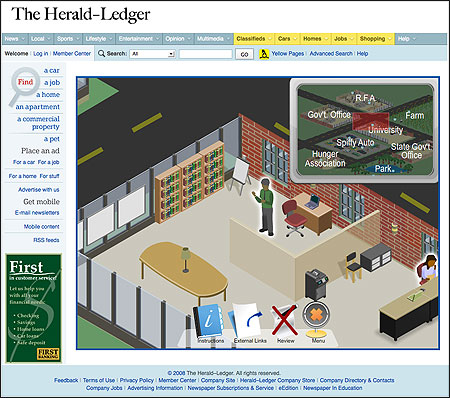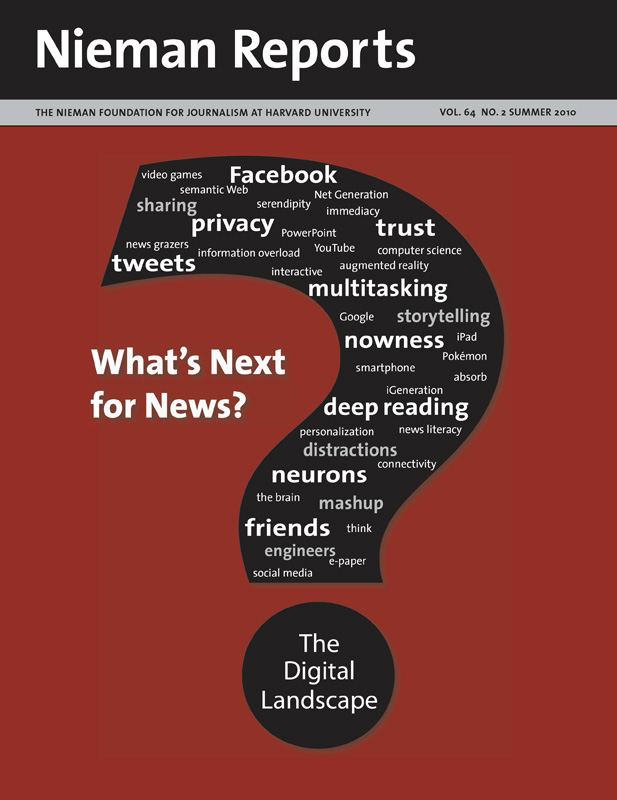
Five ways to tell “boring but important” stories were tested in a study called “Playing the News.” Stories involving the use of ethanol for fuel were presented both in traditional ways and as games to 197 participants in the study. While it features a graphical presentation, the role playing game was the least effective of the five models tested.
Reporters employ sounds and images in place of text. Users engage with information and data in ways that resemble how they play video games—manipulating interactive elements to create their own experience with the content. But what impact does such storytelling have on its audience—especially when the content is news?
Journalists are experimenting with different presentations of online news even though there isn’t a lot of research to tell them whether such storytelling techniques work with news, or if they do, how and why.
Some news stories are ripe candidates for creative multimedia storytelling. Two good examples are The New York Times’s graphic depiction of a crane accident and The Virginian-Pilot’s coverage of the challenges people with brain injuries face.
Yet such coverage is often reserved for long-term projects or compelling news events. What happens with ongoing coverage of issues or with events that occur with consistency over time and require that a thread of context run through the storytelling? Matt Thompson addressed aspects of this digital challenge in “An Antidote for Web Overload” in the Fall 2009 issue of Nieman Reports. He observed how difficult it can be for readers—especially younger ones—to tune into stories that are a part of ongoing news coverage of events or issues unfolding over time. The Associated Press affirmed this observation when it conducted a study to evaluate how best to engage young people in news reporting—and devised a digital strategy to convey its news reporting in more inviting and accessible ways.
Playing the News
RELATED ARTICLE
“Playing the News Moves Into the Classroom”
- Nora Paul and Kathleen A. HansenA few years ago the Knight News Challenge awarded us $250,000 for a two-year study designed to explore what would happen when news-focused games were devised with the purpose of engaging an audience. We named our proposal “Playing the News,” and our goal was to learn about the potential for telling process-oriented stories in accessible and absorbing ways.
To do this, we tested five online versions of stories about the issues involved with using ethanol for fuel; two were presented in game formats; the other three relied on more traditional formats. All versions contained the same information but each presented it very differently. Ethanol worked well as a topic because of the differing perspectives we featured—from farmers, environmentalists and legislators, to name a few—and because it is often covered as an ongoing, process-oriented story. It was also one of those “boring but important” stories that was perfect, in our estimation, to test whether a more engaging presentation would help people find their way into the story.
In one game the player or the person coming to the news story moved around in a simulated environment comprised of people who provided facts and various perspectives about the issue. Each player could choose locations to visit and which characters to question; at each location the player could click through multiple dialogue boxes to get information from different perspectives.
The second approach used a game board to expose each player to facts and the perspectives of different stakeholders. The player was dealt cards, rolled the dice, and moved a marker to the appropriate area where an answer might be found. Once the player arrived there, all of the answer cards were activated so the player would see all of the information relevant to that stakeholder’s perspective. Then the player was asked to select the right answer, based on what he had learned.
We created three other formats based on standard news Web sites. In one version, the information about ethanol as fuel was shown as a conventional analysis/explanatory story in news-column format. In another, we presented the same information but organized the material by topics, (e.g., Quick Facts, Ethanol: Government) and provided a summary under each topic with links to related content. Our last approach presented the information as a simplified blurb—serving as a headline for this topic—with a set of links, in reverse chronological order, to the news organization’s stories about ethanol.
To test the various digital-story formats, we recruited 197 people who ranged in age from their teens to their late 70s. Slightly more than half were women. The participants, randomly assigned to one of the five formats, spent as much time as they liked with the material before filling out a survey. We wanted to determine their interest in the topic, their knowledge about it, and their engagement with and opinions about the story format they saw.

The most highly rated format, above, organized the material in the ethanol story by topic and provided a summary for each topic with links to related content.

The board game model, below, proved to be one of the more effective designs tested so the authors released it as an iPhone app.
What Worked?
With the measuring tools we used to assess their responses, we arrived at some conclusions about what worked and what didn’t work with each of these five formats:
Simulation Game: This version ranked the lowest on virtually all of our measures. From participants’ comments it was clear that when people seek news they want to acquire the information quickly and easily. While this kind of simulation game is effective in teaching and training, it did not appear to be a viable way to present information for a casual news audience.
Board Game: The board game tested well as far as the amount of information read and whether or not the experience was fun. Based on the feedback we received, the board/quiz style game seemed to be an effective and engaging way to present an array of information about such a topic. The amount of time people spent online was also the highest with this version—an important measure for news organizations looking to sell their audience to advertisers. Because this game seemed attractive to the audience, we created a mobile version of it for the iPhone; since January more than 1,000 people have downloaded the free app.
Traditional News Story: This format proved effective for getting people to read about the topic in detail. People also said they would think highly of a news organization that presented information in this familiar way.
Topic-Organized Facts and Links: This method of absorbing information was by far the favorite approach of those we tested. People found it an excellent way to present news about serious topics; this format interested them in the topic more than the way news stories are usually presented. They also found that the information was easier to understand compared with a traditional news story. Those assigned to this format were also most likely to say they learned something new about the topic. It also generated the most positive responses to the statement “I would think highly of a news organization that presented stories this way.”
Blurb With Reverse-Chronologically-Organized Collection of Links: This format generated the most negative reaction of the three traditional methods of presenting a news story. It turned out to be the least-engaging format and made the information harder to understand. Those who received information in this way would not think highly of the news organization. Keep in mind that this is a common way that news organizations digitally display their archive of stories for ongoing coverage.
A game format clearly is not a good fit for news stories involving differing perspectives and ongoing coverage. For lighter topics such as “Should I get a cat or a dog?” or trivia, a news game might be more appropriate. Much of the appeal of a news game would be in enabling multiple players to move through the game at the same time, thus adding a competitive element—and this is something our games didn’t have.
As we developed these game systems, we started to see interesting opportunities for these projects to generate revenue, such as by embedding sponsorships, coupons and other similar elements. This is an area ripe for testing in the next iteration of the study.
The most compelling finding was the popularity of the topic-organized format. For ongoing, process-oriented news stories, readers appear to want to have their experience be guided, in this case, by journalists. This speaks to the curatorial function that many news organizations are starting to explore. The curated version helped them in absorbing the big picture and then they relied on the topic-organized facts and links to point them toward additional, in-depth information. Our participants’ experiences coincide with what Thompson discovered when people used his experimental, context-laden Web sites, The Money Meltdown and Columbia Tomorrow. And when a news organization presented information in this way—as our curated site did, readers expressed a high level of satisfaction.
As news organizations look for ways to create content and develop online experiences that are valued, these results should be kept in mind. With younger readers, in particular, who report feeling lost in their attempt to follow ongoing process stories, such topic-organized pages could be a promising way to engage readers and build brand loyalty.
Right now the opportunities news organizations have to tell digital stories far exceed the knowledge that any of us have about how these choices affect the audience’s experience. Yet research such as ours is starting to provide clues. Our hope is that news organizations will seek out such information as they expand their use of multimedia and information visualization.
Ultimately our challenge will be to determine which metrics for successful storytelling turn out to be most important in the digital environment. We already know that this can be a complicated picture. For example, what our research reveals is that while one style might have the greatest impact in one area (e.g., time spent online) another has impact in another area (e.g., “I learned something new.”). Digital storytelling possibilities often seem limitless as new tools emerge with a rapidity that can outpace our knowledge of their effectiveness. Yet efforts are underway that can provide guidance, ours being one of them. And news organizations—as they experiment with these new storytelling formats, as surely they must do—might want to take a look at what is known about which form works well for which story.
Nora Paul and Kathleen A. Hansen teach in the School of Journalism & Mass Communication at the University of Minnesota. Playing the News, their research project, was funded by the John S. and James L. Knight Foundation’s News Challenge grant program from 2007 to 2009.



